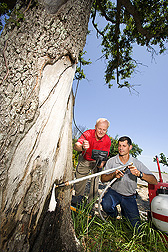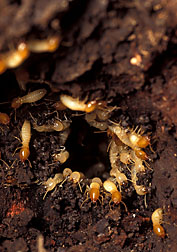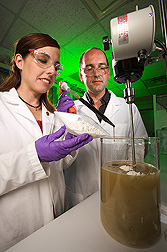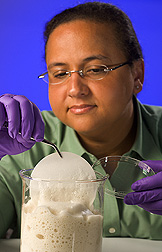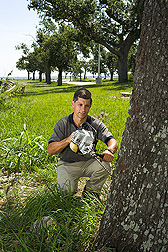Fungal Foam Seeks and Destroys Termites
About 850 miles separate Peoria, Illinois, from New Orleans, Louisiana. But that hasn’t stopped a team of Agricultural Research Service (ARS) scientists in the two cities from plotting ways to sabotage pesky subterranean termites.
On behalf of the scientists—Christopher A. Dunlap, Mark A. Jackson, and Maureen S. Wright—ARS applied for a patent in September 2006 on a first-of-its-kind foam they developed to control the pests biologically. Rather than deliver a slow-acting insecticide, as do other foam products now sold, the scientists’ formulation exposes termites to spores of the fungus Paecilomyces fumosoroseus. On contact, the fungus sends threadlike filaments called “hyphae” into the termites’ bodies. It then starts to feed and grow, killing its hapless victims within a few days.
It’s a gruesome end for sure, but one not likely to earn the sympathy of homeowners, building managers, or others whose property has been ravaged by the pests.
|
|
Formidable Formosans
Each year, termites cost an estimated $1 billion in U.S. property damage, preventive measures, and structural repairs. Among the worst offenders—and top target on the scientists’ hit list—is Coptotermes formosanus. In the southern and southwestern United States, this termite is unrivaled in the size of its colonies, tunneling, and appetite for cellulose in wood materials and living trees. In New Orleans alone, this nonindigenous species causes an estimated $300 million annually in losses.
But if ongoing field studies in New Orleans are any indication, the innovative fungal foam could make life a good bit more difficult for the Formosan termite. The scientists developed the concoction to improve the fungus’s capacity to biologically control this foreign pest and its native subterranean brethren.
Some insecticide compounds simply repel the pests, which then go forage elsewhere. Other insecticides are nonrepellent and are applied as either liquids or baits, where they serve as slow-acting poisons.
Today’s pesticides must be reapplied after a few years to maintain a barrier around the foundations of homes and other structures. Earlier termite treatment chemicals, such as chlordane, persisted in the environment for long periods. But all the old standards have been discontinued because of environmental and human health concerns.
Paecilomyces and other insect-killing fungi that the team is considering are just as lethal as chemical pesticides. And as biological control agents, they are better for environmentally sensitive areas, say Dunlap, a chemist, and Jackson, a microbiologist. Both are in the Crop Bioprotection Research Unit at ARS’s National Center for Agricultural Utilization Research in Peoria. Wright, a microbiologist, is in the Formosan Subterranean Termite Research Unit at the agency’s Southern Regional Research Center (SRRC) in New Orleans.
Operation Fungal Foam
Paecilomyces was the team’s first choice for use with the foam because of Jackson’s extensive experience in mass-producing and formulating its spores for use against silverleaf whiteflies and other crop pests.
As a host-specific fungus, it only infects members of certain insect families. It poses little known danger to beneficial insects such as bees, or to humans, pets, or other animals.
In the lab, Dunlap examined more than a dozen foaming agents—some synthetic, others food grade—for compatibility with Paecilomyces. That meant finding one that wouldn’t kill the fungus or diminish its ability to form spores and grow (germinate).
After extensive testing, he chose a commercially available protein called “keratin hydrolysate.” It’s a smaller, water-soluble version of the keratin that’s found naturally in animal hooves and horns, fish scales, hair, wool, feathers, and other sources.
Dunlap traces keratin’s first industrial uses to fire-fighting foams of the 1940s. During World War II, for example, it served as a substitute for petroleum, which was in short supply. Today, petroleum-based foaming agents are once again the norm, including for insect-control applications.
|
|
Besides checking for compatibility with Paecilomyces, the ARS team observed that the protein has a beneficial effect on the fungus’s ability to control termites. That is, fungi in foam killed more termites than fungi in water. The scientists note that the foam causes the spores to germinate faster than they normally would—a feature that could improve Paecilomyces’s effectiveness. The foam’s chemical properties also allow the spores to stick better to the termites.
To create the foam, the scientists mixed keratin hydrolysate with water, fungal spores, nutrients, and ingredients called “adjuvants,” which help the spores cling to treated surfaces.
A fiber-optic video camera, supplied by collaborators from the New Orleans Mosquito and Termite Control Board, enabled the ARS team to watch the foam in action and to check for its impact on termite activity in trees they had treated for the outdoor phase of their studies.
Treatment involves drilling some small holes in a tree’s trunk and then injecting the foam inside those holes, where it can creep and expand into any cavities or tunnels the pests have made in the heartwood. After about 25 minutes or so, the foam collapses, depositing the fungal spores to act like thousands of tiny, termite-killing landmines.
With the fiber-optic camera, says Dunlap, “You can see the termites running, with the foam coming in behind them.” If not directly coated with spores, the termites later pick them up while resuming their foraging or grooming of one another back at the nest. A sign the spores have taken effect is the termites’ failure to plug the drill holes several days after treatment, notes Dunlap. Another is moldy cadavers.
|
|
Of Hurricanes and Survival
Despite such high-tech surveillance, the scientists still had many questions about the all-natural biological control they were developing. How slow acting is the fungus? Can it be easily passed from termite to termite? What formulation is most enticing to foraging termites?
But of all their questions, they never guessed that they’d find answers to this one: How will the fungal foam fare under hurricane conditions?
Wright was in the midst of carrying out long-term field studies on Paecilomyces when Hurricane Katrina struck in August 2005. Several months before, she’d injected the fungal formulation into several termite-infested trees located in City Park, a 1,300-acre green space situated near the heart of New Orleans.
City Park contains hundreds of cherished tree specimens, including the largest collection of mature live oaks in the world. Some of these moss-draped giants predate the city by three centuries or more. While more than 1,000 trees in City Park were toppled or suffered wind damage, most survived Katrina. But the same may not be said about their ability to outlive the wood-hungry Formosan termite.
New Orleans’s termites are known as hardy underground dwellers, but even ARS researchers were surprised to learn how many persisted through the flooding and upheaval inflicted by Katrina. SRRC entomologists Mary Cornelius and Weste Osbrink tracked the pests before and after the storm, across City Park and elsewhere, and found that around 80 percent of their research traps were still crawling with termites just a month after the hurricane had struck.
Fortunately, Paecilomyces has been equally tenacious. Despite Katrina’s impact on her City Park study area, Wright reports that she’s still seeing significant control of termites.
“Even after Katrina,” says Wright, “we still have seen little to no termite activity in the treated trees.”
The researchers experienced one major drawback, though: Katrina wiped out trees serving as Wright’s controls. Other of her research trees were badly damaged and must now be removed by city officials to make space for new plantings. For these reasons, Wright won’t be able to continue to monitor the trees, as she’d hoped.
But to follow up, she kicked off another field study this past spring. “Also taking place in City Park, this study will eventually involve many more trees, which will give us more confidence in our findings,” she says.
What excites Wright about the fungal foam is that in addition to terminating termites, the method uses all-natural components. “Treatments currently being used on trees and in buildings are largely chemical,” she says. “Our method is a nice option for consumers who like knowing that the termite treatment being used in their homes or yards is biologically based.”
The fungal foam is just one of many control methods being developed by ARS researchers. Ultimately, they’d like to have ready an entire toolbox of termite treatments for use in various scenarios. As Hurricane Katrina proved, they’ll need all the help they can get in outwitting the Formosan subterranean termite, which seems uniquely programmed for survival.—By Jan Suszkiw and Erin K. Peabody, Agricultural Research Service Information Staff.
This research is part of Crop Protection and Quarantine (#304) and Veterinary, Medical, and Urban Entomology (#104), two ARS national programs described on the World Wide Web at www.nps.ars.usda.gov.
Christopher A. Dunlap and Mark A. Jackson are in the Crop Bioprotection Research Unit, USDA-ARS National Center for Agricultural Utilization Research, 1815 N. University St., Peoria, IL 61604-3902; phone (309) 681-6283 [Jackson], (309) 681-6339 [Dunlap], fax (309) 681-6693.
Maureen S. Wright is in the USDA-ARS Formosan Subterranean Termite Research Unit, Southern Regional Research Center, 1100 Robert E. Lee Blvd., New Orleans, LA 70124; phone (504) 286-4294, fax (504) 286-4419.
"Fungal Foam Seeks and Destroys Termites" was published in the September 2007 issue of Agricultural Research magazine.







